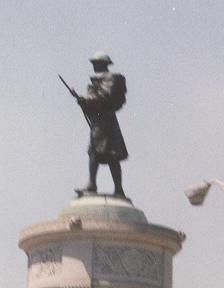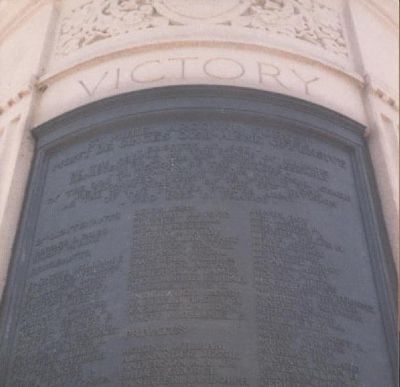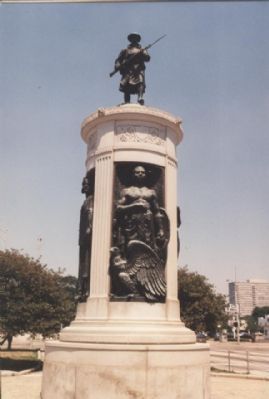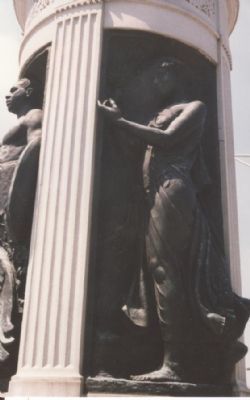Douglas (Bronzeville) in Chicago in Cook County, Illinois — The American Midwest (Great Lakes)
Victory, World War I Black Soldiers’ Memorial
Inscription.
Victory
St. Mihiel, Argonne Forest, Mont de Signes, Oise-Aisne Offensive.
In memory of the heroes of the old 8th Infantry, Illinois National Guard, redesignated during the World War as the 370th Infantry of the United States Army who died in France.
[Honor Roll of the Dead. Names of 137 members of the Eighth Infantry, Illinois National Guard, who lost their lives during World War I]
Erected 1927 by the people of the State of Illinois, represented in the 54th General Assembly.
Topics. This memorial is listed in these topic lists: African Americans • War, World I.
Location. 41° 49.845′ N, 87° 37.028′ W. Marker is in Chicago, Illinois, in Cook County. It is in Douglas (Bronzeville). Memorial is at the intersection of Dr. Martin Luther King Drive and East 35th Street, in the median on Dr. Martin Luther King Drive. Marker is on the north side of the monument which is nine blocks east of the Dan Ryan Expressway (I-90/I-94). Touch for map. Marker is in this post office area: Chicago IL 60616, United States of America. Touch for directions.
Other nearby markers. At least 8 other markers are within walking distance of this marker. Supreme Life Building (within shouting distance of this marker); The Boulevard System (within shouting distance of this marker); Sunset Cafe (about 400 feet away, measured in a direct line); Ida B. Wells-Barnett (about 800 feet away); The Ida B. Wells Homes (approx. ¼ mile away); Chicago Defender Building (approx. ¼ mile away); Camp Douglas (approx. 0.3 miles away); Douglas Plaza (approx. 0.3 miles away). Touch for a list and map of all markers in Chicago.
More about this memorial. The first state-sponsored memorial to Afro-American veterans of World War I, the Victory monument is located in the heart of Chicago's historic "Black Metropolis/Bronzeville" district on the city's near South Side.
In 1927, the State of Illinois erected this monument in the Chicago neighborhood known as "Bronzeville," which was home of the "Fighting Eighth" Regiment of the Illinois National Guard. The names of 137 members of the Eighth Infantry, Illinois National Guard, who lost their lives during World War I are inscribed on a bronze panel. The Eighth Regiment of the Illinois National Guard was reorganized as the 370th U.S. Infantry of the 93rd Division, and this regiment saw service on WWI major battlefields, distinguishing itself as the last regiment pursuing
the retreating German forces in the Aisne-Marne region of France, just before the Nov. 11, 1918 Armistice.
The monument is a white granite shaft topped with a bronze doughboy sculpture. On the monument's shaft are three bronze relief panels depicting life-sized figures.
(Victory Panel): Left full-length profile of a Classically draped African-American female figure representing motherhood. In her hand she holds a branch symbolizing Victory.
(Columbia Panel): Full-length Classically draped female figure with a helmet on her head. In her proper left hand she holds a tablet inscribed with the names of battles in which African-American soldiers fought.
(African-American Soldier Panel): A bare chested African-American soldier of the 370th Infantry, which fought in France, standing with an eagle in left profile in front of him.
The doughboy on top of the shaft was added in 1936.
The monument was designated an official city landmark in 1998.
Regarding Victory, World War I Black Soldiers’ Memorial. The 8th Illinois traced its lineage to "Colored" militia units that were formed in the state as early as 1873. It was mustered into federal service during both the Spanish-American War and the Mexican Punitive Expedition, prior to becoming the 370th U.S. Infantry Regiment for service
in France during WWI.
It was the first racially segregated U.S. regiment to go to war with a full complement of Black commissioned officers, including its commanding officer in 1917, Col. Franklin A. Dennison.
Along with the other all-Black, former national guard units that comprised the 93rd U.S. Infantry Division, the 370th was seperately assigned to French Army command, fought using French Label rifles and usually wore the poilu’s distinctive, Adrian-style helmet in combat. Attached to the 34th, 36th, and 59th French Infantry Divisions at different times, it fought with distinction with the French Tenth Army in the Oise-Aisne Offensive of August-September, 1918, suffering at least 105 dead.
Also see . . . 8th Infantry, Illinois National Guard Association. Facebook page (Login requirerd) (Submitted on July 28, 2021, by Larry Gertner of New York, New York.)

Photographed By Richard E. Miller, 1995
4. "The Doughboy"
Statue atop the monument depicts a soldier carrying an American Springfield rifle and wearing the standard U.S. Army helmet of 1917-18. However, the men of the 370th Infantry would more likely have been carrying the French Label rifle and wearing the French "Adrian" helmet in the actions in which they were engaged.
Credits. This page was last revised on January 30, 2023. It was originally submitted on January 12, 2008, by Richard E. Miller of Oxon Hill, Maryland. This page has been viewed 7,582 times since then and 50 times this year. Photos: 1, 2, 3, 4. submitted on January 12, 2008, by Richard E. Miller of Oxon Hill, Maryland. • Kevin W. was the editor who published this page.
Editor’s want-list for this marker. A clear photograph of the names on the monument, so they can be transcribed • or a list of the names inscribed on the monument so we may add them to the transcription • Can you help?


